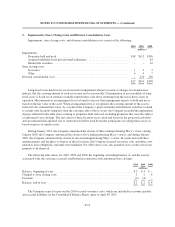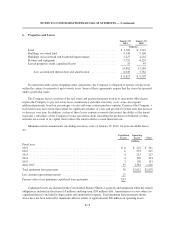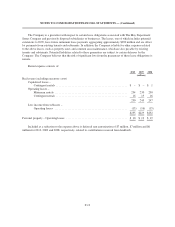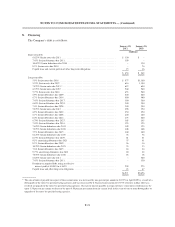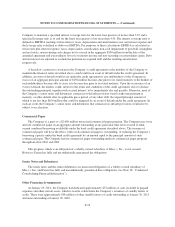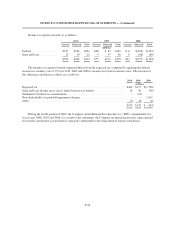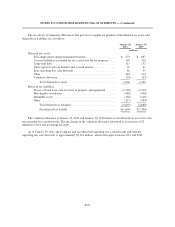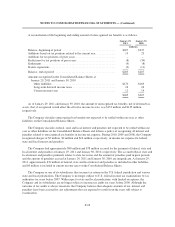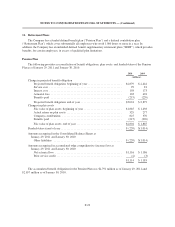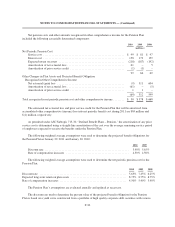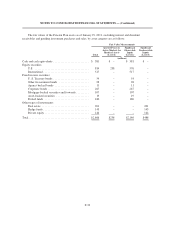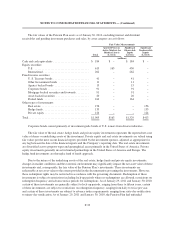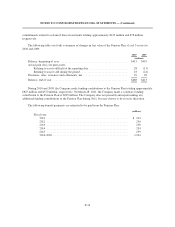Macy's 2010 Annual Report Download - page 72
Download and view the complete annual report
Please find page 72 of the 2010 Macy's annual report below. You can navigate through the pages in the report by either clicking on the pages listed below, or by using the keyword search tool below to find specific information within the annual report.
NOTES TO CONSOLIDATED FINANCIAL STATEMENTS — (Continued)
Company to maintain a specified interest coverage ratio for the latest four quarters of no less than 3.25 and a
specified leverage ratio as of and for the latest four quarters of no more than 4.50. The interest coverage ratio is
defined as EBITDA (earnings before interest, taxes, depreciation and amortization) over net interest expense and
the leverage ratio is defined as debt over EBITDA. For purposes of these calculations EBITDA is calculated as
net income plus interest expense, taxes, depreciation, amortization, non-cash impairment of goodwill, intangibles
and real estate, non-recurring cash charges not to exceed in the aggregate $500 million from the date of the
amended agreement and extraordinary losses less interest income and non-recurring or extraordinary gains. Debt
and net interest are adjusted to exclude the premium on acquired debt and the resulting amortization,
respectively.
A breach of a restrictive covenant in the Company’s credit agreement or the inability of the Company to
maintain the financial ratios described above could result in an event of default under the credit agreement. In
addition, an event of default would occur under the credit agreement if any indebtedness of the Company in
excess of an aggregate principal amount of $150 million becomes due prior to its stated maturity or the holders of
such indebtedness become able to cause it to become due prior to its stated maturity. Upon the occurrence of an
event of default, the lenders could, subject to the terms and conditions of the credit agreement, elect to declare
the outstanding principal, together with accrued interest, to be immediately due and payable. Moreover, most of
the Company’s senior notes and debentures contain cross-default provisions based on the non-payment at
maturity, or other default after an applicable grace period, of any other debt, the unpaid principal amount of
which is not less than $100 million that could be triggered by an event of default under the credit agreement. In
such an event, the Company’s senior notes and debentures that contain cross-default provisions would also be
subject to acceleration.
Commercial Paper
The Company is a party to a $2,000 million unsecured commercial paper program. The Company may issue
and sell commercial paper in an aggregate amount outstanding at any particular time not to exceed its then-
current combined borrowing availability under the bank credit agreement described above. The issuance of
commercial paper will have the effect, while such commercial paper is outstanding, of reducing the Company’s
borrowing capacity under the bank credit agreement by an amount equal to the principal amount of such
commercial paper. The Company had no commercial paper outstanding under its commercial paper program
throughout all of 2010 and 2009.
This program, which is an obligation of a wholly-owned subsidiary of Macy’s, Inc., is not secured.
However, Parent has fully and unconditionally guaranteed the obligations.
Senior Notes and Debentures
The senior notes and the senior debentures are unsecured obligations of a wholly-owned subsidiary of
Macy’s, Inc. and Parent has fully and unconditionally guaranteed these obligations (see Note 18, “Condensed
Consolidating Financial Information”).
Other Financing Arrangements
At January 29, 2011, the Company had dedicated approximately $52 million of cash, included in prepaid
expenses and other current assets, which is used to collateralize the Company’s issuances of standby letters of
credit. There were approximately $38 million of other standby letters of credit outstanding at January 29, 2011
and none outstanding at January 30, 2010.
F-24


